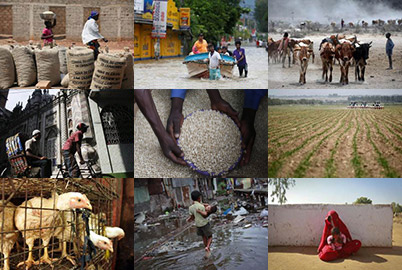Mohammed spoke to Peter Biro of aid agency International Rescue Committee (IRC) in early July 2006.
Mohammed is drawing a camel under a big sun on a piece of paper. The dry desert wind is moving the tent flap slowly back and forth, and he occasionally peers out to look at his friends playing volleyball in the yard outside.
"That&${esc.hash}39;s my best friend, Ali," Mohammed says, pointing at a boy preparing to serve the ball across the net.
Sitting on a straw mat in a children&${esc.hash}39;s centre run by the International Rescue Committee (IRC) in the war-torn Darfur region of Sudan, Mohammed goes back to his drawing.
Just like his newfound playmate, Mohammed was forced to flee with his parents when his village was attacked seven months ago. He says that Janjaweed - as pro-government militia are called in this part of the world - arrived in the morning, firing their guns in the air.
"They told us all to leave," he says. "I ran away with my mother and my sister. I still don&${esc.hash}39;t know what happened to my father."
They hid on the outskirts of town for several days before moving north towards Nyala, the main town in South Darfur.
"We didn&${esc.hash}39;t have any water or food. We knew that there were many people in Nyala and that we could get help," Mohammed says. "It took us many days to walk here."
Around Nyala, up to 150,000 people have sought shelter from the ongoing atrocities. Many have lived here since 2003, when the civilian population of Darfur first came under attack.
Outside the centre, row after row of makeshift huts built from straw and plastic sheeting stretch for several kilometres across the desert sand. Improvised shelters made from mats and sticks are evidence that newly displaced people continue to pour into this part of Darfur, despite a peace agreement signed in May by the largest of the Darfur rebel groups and the Sudanese government.
Mohammed spends as much time as he can at the children&${esc.hash}39;s centre, playing and reading.
"When I&${esc.hash}39;m not here, I have to work to help my family," Mohammed says. "I get up early in the morning to get the donkey. I rent it from a man living near me. And then I go outside the camp to collect water from the wells. I sell it to people in the camp and split what I earn with the owner of the donkey. I make about 250 dinars (${esc.dollar}1) a day."
Next to Mohammed sits Umelhassan Yusuf, who runs IRC&${esc.hash}39;s child programmes here. Janjaweed drove her from her home in the North Darfur town of Kuttum in 2003, early in the conflict. When she first started working with the children, Umelhassan says they would often just sit quietly, or cry.
Some wanted to talk about how their villages were attacked and burnt to the ground.
"When we asked them to draw, they drew people with guns shooting," she says. "We tried to help by talking to them and mixing in a lot of fun and play. And after a while the situation slowly changed and they managed to forget some of their trauma.
"When they draw today, it is pictures of flowers and people shaking hands. Our role is not only to teach children new things but also to make them relax and enjoy being children."
Pulling out a fresh sheet of drawing paper, Mohammed says he didn&${esc.hash}39;t have many friends when he first arrived in the Sekeli camp on the outskirts of Nyala.
"I didn&${esc.hash}39;t know anyone because they all came from different villages and I was too shy to talk to them," he says. Now he&${esc.hash}39;s made friends.
"I like Ali the best. He is younger than me, seven years old, and lends me his coloured pencils when we draw pictures."
The future for Mohammed and Darfur&${esc.hash}39;s myriad other displaced people is highly uncertain. Attacks on civilians and aid workers are increasing and the threat of marauding militia groups is compounded by clashes between the divided rebel Sudanese Liberation Army (SLA), increased inter-tribal feuds and banditry.
Political tension has also increased inside the camps, as many displaced people in the southern part of Darfur are loyal to an SLA faction that refused to sign the peace agreement. And humanitarian workers complain that the lack of policing and overcrowded conditions have led to an increase in crime and insecurity inside the camps.
Whatever the future might bring to this troubled province, Mohammed doesn&${esc.hash}39;t hesitate when asked what he wants to do when he&${esc.hash}39;s older.
"I want to become a teacher. I like the teachers here and I want to help all the small children who can&${esc.hash}39;t go to school."
Read about the AlertNet poll of child danger spots:
- LEAD STORY: Sudan is most dangerous place for children - poll
- CONGO CASE STUDY: Aimerance, girl soldier
- UGANDA CASE STUDY: Mary&${esc.hash}39;s sisters, &${esc.hash}39;night commuters&${esc.hash}39;
Visit theirc.org or www.ircuk.org to find out more about IRC&${esc.hash}39;s work in Darfur, Sudan.
Find out more in our Darfur crisis briefing.
Any views expressed in this article are those of the author and not of Reuters.Our Standards: The Thomson Reuters Trust Principles.

